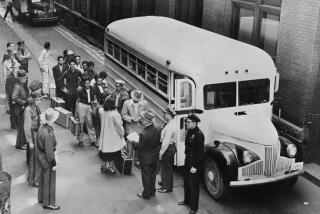ART : Laguna Museum Provides Temporary Refuge for Controversial Sculpture
- Share via
Stories of exiled artists are hardly new.
Driven from home by politics, they build new lives on distant shores, sometimes acquiring a special refugee glamour. Yet exiles are uncomfortable presences. Even when they don’t try to provoke, they often come to symbolize unresolved conflicts and lingering pain in the places they left behind.
The Laguna Art Museum is host these days not to an exiled artist but to an exiled piece of art: Robert Arneson’s “Portrait of George,” a memorial sculpture of slain San Francisco Mayor George Moscone.
Moscone was assassinated in 1978 by Dan White, whom the mayor was about to replace on the county Board of Supervisors. White also killed Supervisor Harvey Milk, a gay rights activist who was himself the subject of many memorializing gestures and a widely distributed documentary film.
Born of violence and urban strife, the Moscone piece now stands in a corner of the entrance to an area of an all-pink museum in a seaside resort town. The incongruity of this object in this context is jarring. From behind the charismatically good-natured smile of the warmly handsome politician, one can almost hear Moscone whisper: “What am I doing here?”
The answer is political. Arneson was one of six artists commissioned by the City of San Francisco to come up with something for the opening of Moscone Center, San Francisco’s convention center, in December, 1981. Instead of giving the city a heroically generalized image of a fallen leader, Arneson offered a larger-than-life bust with an accessibly (but not sentimentally) human aura.
The bust stands atop a pedestal etched, graffiti-style, with words and symbols that force a viewer to consider the details of Moscone’s life--and his death. The piece has a documentary, playfully Brechtian quality. It is art as journalism.
Too much so for some. “The chief of the city Fire Department was walking by before the dedication, saw the piece and got all upset,” Arneson said last week by phone from his home near San Francisco. “You see, Dan White was a fireman and I had references to him and the killing. I have an impression of a gun in the pedestal and five bullet holes.
“The fire chief went to the mayor (Dianne Feinstein),” Arneson said. “She got all upset and ordered that the pedestal be covered during the dedication, so you couldn’t see the pedestal.”
All-embracing in its reportage, the pedestal also includes the image of a Twinkie. It is a daisy-yellow oblong of color, but its message is outrage: White, charged with first-degree murder, was convicted of voluntary manslaughter after his lawyers formulated the “Twinkie defense,” the premise that White’s judgment during the slayings was dimmed by his addiction to junk foods.
Such details prompted outrage against Arneson’s work. Newspapers ran photo-enlargements of the five bullet holes. Moscone’s wife denounced the work. The city art commission voted to reject it. Arneson returned the $18,500 advance he had received on the $37,000 commission. “Portrait of George” moved from one museum to another for several months, until private collector Foster Goldstrom bought it. Like a restless ghost, it continued to wander, to Washington, Minneapolis, Oakland. It has been in Laguna since May; its next stop may be Davenport, Iowa.
“They wanted me to portray a white knight on a white horse, and I wasn’t going to do that,” said Arneson, 57, a highly recognized artist whose sculpture has been shown at major museums around the country. “I paid a price in one respect, but the piece certainly is getting around.”
Arneson never met Moscone but refers to him by his first name.
“When you get to working on something of this nature, you start identifying with the person. I always thought that he was with me as I was making it, having a good time. I could imagine him telling me: ‘Tell them, Bob, tell them.’ . . . I felt I was telling a story and I wanted to tell it as well as I could. I never felt I did him a dishonor.”
Some day, Arneson says, he’d like to see “Portrait of George” back in the city where Moscone was mayor. “I think it should be in the rotunda of City Hall. It’s really very fragile and I think it should be in one place. It’s hollow and the clay is only 1 1/2 inches thick. I’m afraid it won’t hold up, because it was not made to be traveling like this, from place to place.”
Like an exile.
More to Read
The biggest entertainment stories
Get our big stories about Hollywood, film, television, music, arts, culture and more right in your inbox as soon as they publish.
You may occasionally receive promotional content from the Los Angeles Times.










